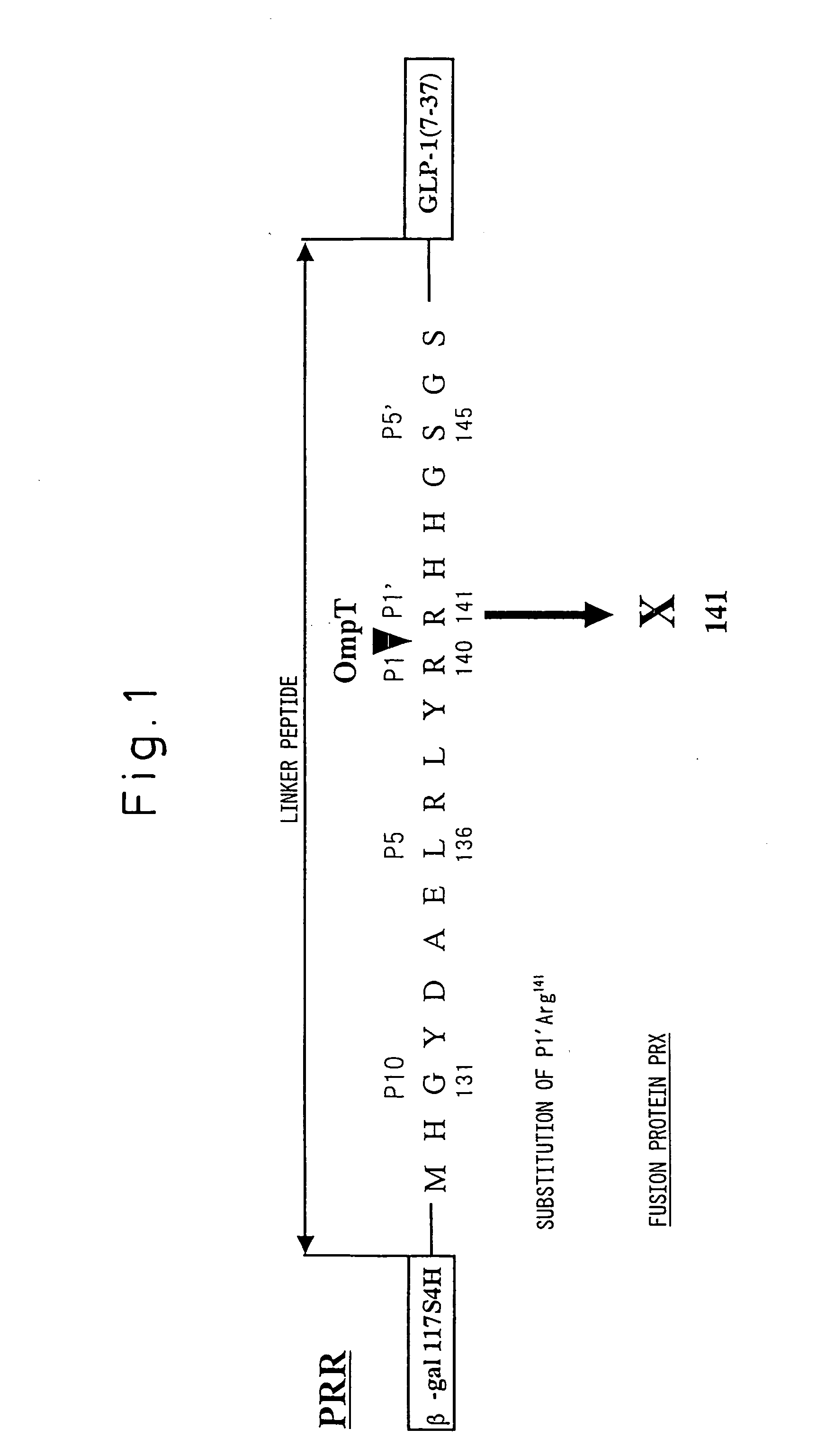Polypeptide cleavage method using ompt protease variant
a polypeptide and oligopeptide technology, applied in the field of polypeptide cleavage method using ompt protease variant, can solve the problems of limited n-terminal amino acids for efficiently cleaving target polypeptides, unsuitable industrial mass processing of peptides and proteins by fusion protein methods, and inability to efficiently cleave target polypeptides
- Summary
- Abstract
- Description
- Claims
- Application Information
AI Technical Summary
Benefits of technology
Problems solved by technology
Method used
Image
Examples
example 1
Preparation of Fusion Proteins PAn
[0144] OmpT protease is an endoprotease found in E. coli outer membrane. Since the basic amino acids in the amino acid sequence adjacent to the cleavage site have a major effect on cleavage by this enzyme, the present inventors utilized the known cleavage site of the enzyme for the experiment described below to investigate the relationship between the basic amino acid position and the cleavage efficiency.
[0145] Arginine was substituted for alanine at positions P10 to P2 and positions P2′ to P5′ of the cleavage site of the fusion protein PA (a fusion protein comprising the protecting protein deriving from 117 amino acids from the N-terminus of E. coli β-galactosidase (β-gal117S4H) and human glucagon-like peptide-1(7-37) (GLP-1(7-37) via a linker peptide) shown in FIG. 2 having a structure which is cleaved by OmpT protease, to create the fusion proteins PAn (FIG. 2: where n corresponds to the amino acid position [Pn] in the cleavage site, from P10 t...
example 2
Cleavage of Fusion Proteins PAn by OmpT Protease
[0147] The cleavage efficiency by OmpT protease was examined using each fusion protein PAn (FIG. 2) wherein arginine was substituted for different alanines adjacent to the OmpT protease cleavage site of the fusion protein PA shown in FIG. 2, which has a structure that is cleaved by OmpT protease. Each PAn was reacted with an OmpT protease sample purified using Benzamidine Sepharose 6B at pH 7.0 according to Japanese Patent Application No. 2000-602803. FIG. 2 also shows the cleavage efficiencies obtained from the results of HPLC analysis after the enzyme reaction. FIG. 2 further shows the cleavage sites obtained from the results of mass analysis.
[0148] All of the PAn proteins underwent cleavage by OmpT protease at the same site as PA, while PA2, PA2′ and PA3′ also underwent cleavage at other sites (FIG. 2). In particular, PA3′ was cleaved at the two sites Arg140-Arg141 and Arg143-Ala144 (cleavage efficiencies: 220%, 73%), thus indicat...
example 3
Preparation of Fusion Proteins PA1A3′ PA1′A3′
[0150] OmpT protease is known to be an enzyme which cleaves primarily between consecutive basic amino acids. However, the results of Example 2 demonstrated that the fusion protein PA3′ is cleaved at two sites: Arg140-Arg141 and Arg143-Ala144, and that one of them is -Arg↓Ala-cleavage. The cleavage efficiency at -Arg↓Ala- is low compared to the cleavage efficiency between basic amino acids, but it was speculated that this could be improved to an industrially useful cleavage efficiency.
[0151] Therefore, in order to inhibit cleavage at Arg140-Arg141 among the two cleavage sites Arg140-Arg141 and Arg143-Ala144 of the fusion protein PA3′, there were prepared fusion proteins PA1A3′ and PA1′A3′ (FIG. 3) having an amino acid sequence with alanine substituting for Arg140 or Arg141, and their cleavage with OmpT protease was examined. It was also investigated whether Arg140 (position P4, where Arg143 and Ala144 are positions P1 and P1′, respectivel...
PUM
| Property | Measurement | Unit |
|---|---|---|
| temperature | aaaaa | aaaaa |
| temperature | aaaaa | aaaaa |
| pH | aaaaa | aaaaa |
Abstract
Description
Claims
Application Information
 Login to View More
Login to View More - R&D
- Intellectual Property
- Life Sciences
- Materials
- Tech Scout
- Unparalleled Data Quality
- Higher Quality Content
- 60% Fewer Hallucinations
Browse by: Latest US Patents, China's latest patents, Technical Efficacy Thesaurus, Application Domain, Technology Topic, Popular Technical Reports.
© 2025 PatSnap. All rights reserved.Legal|Privacy policy|Modern Slavery Act Transparency Statement|Sitemap|About US| Contact US: help@patsnap.com



